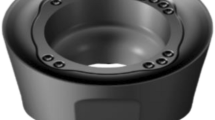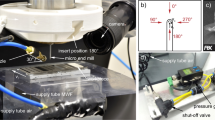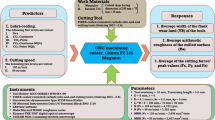Abstract
High speed milling of Inconel 718 by carbide tool aided by MQL of various oil-water ratios and flow rates of the fluid was investigated. Tool wear and cutting force were taken to assess the effectiveness of the fluids. The action of the fluid in machining Inconel 718 under MQL was also studied. EDX analysis of the rake face of the tool shows that the fluid has penetrated into the chip-tool interface and works as the diffusion barrier as well. The results reveal that the amounts of fluid penetration and wetting area are essential for effective fluid action. Tool wear and cutting force are found to decrease with increasing flow rate of the fluid irrespective of oil-water ratio. But the improvements are negligible as compared with those resulted from the flow rates of 100 ml/hr and 60 ml/hr. This can also be confirmed by the little difference of wetting area beyond the flow rate of 60 ml/hr. Based on this study, it is concluded that the most appropriate oil-water ratio and flow rate of the fluid used in MQL in high speed milling of Inconel 718 are 60:40 and 60 ml/hr, respectively.
Similar content being viewed by others
References
Dudzinski, D., Devillez, A., Moufki, A., Larrouquere, D., Zerrouki, V., and Vigneau, J., “A Review of Developments Towards Dry and High Speed Machining of Inconel 718 Alloy,” International Journal of Machine Tools and Manufacture, Vol. 44, No. 4, pp. 439–456, 2004.
Devillez, A., Schneider, F., Dominiak, S., Dudzinski, D., and Larrouquere, D., “Cutting Forces and Wear in Dry Machining of Inconel 718 with Coated Carbide Tools,” Wear, Vol. 262, No. 7, pp. 931–942, 2007.
Thakur, D. G., Ramamoorthy, B., and Vijayaraghavan, L., “Investigation and Optimization of Lubrication Parameters in High Speed Turning of Superalloy Inconel 718,” The International Journal of Advanced Manufacturing Technology, Vol. 50, Nos. 5-8, pp. 471–478, 2010.
Klocke, F. and Eisenblätter, G., “Dry Cutting,” CIRP Annals-Manufacturing Technology, Vol. 46, No. 2, pp. 519–526, 1997.
Kumar, C. R. V. and Ramamoorthy, B., “Performance of Coated Tools during Hard Turning under Minimum Fluid Application,” Journal of Materials Processing Technology, Vol. 185, No. 1, pp. 210–216, 2007.
Kang, M. C., Kim, K. H., Shin, S. H., Jang, S. H., Park, J. H., and Kim, C., “Effect of the Minimum Quantity Lubrication in High-Speed End-Milling of AISI D2 Cold-Worked Die Steel (62 HRC) by Coated Carbide Tools,” Surface and Coatings Technology, Vol. 202, No. 22, pp. 5621–5624, 2008.
Thepsonthi, T., Hamdi, M., and Mitsui, K., “Investigation into Minimal-Cutting-Fluid Application in High-Speed Milling of Hardened Steel using Carbide Mills,” International Journal of Machine Tools and Manufacture, Vol. 49, No. 2, pp. 156–162, 2009.
Dhar, N. R., Ahmed, M. T., and Islam, S., “An Experimental Investigation on Effect of Minimum Quantity Lubrication in Machining AISI 1040 Steel,” International Journal of Machine Tools and Manufacture, Vol. 47, No. 5, pp. 748–753, 2007.
Dhar, N. R., Kamruzzaman, M., and Ahmed, M., “Effect of Minimum Quantity Lubrication (MQL) on Tool Wear and Surface Roughness in Turning AISI-4340 Steel,” Journal of Materials Processing Technology, Vol. 172, No. 2, pp. 299–304, 2006.
Shokrani, A., Dhokia, V., and Newman, S. T., “Environmentally Conscious Machining of Difficult-to-Machine Materials with Regard to Cutting Fluids,” International Journal of Machine Tools and Manufacture, Vol. 57, pp. 83–101, 2012.
Liao, Y. S. and Lin, H. M., “Mechanism of Minimum Quantity Lubrication in High-Speed Milling of Hardened Steel,” International Journal of Machine Tools and Manufacture, Vol. 47, No. 11, pp. 1660–1666, 2007.
Liao, Y., Lin, H., and Chen, Y., “Feasibility Study of the Minimum Quantity Lubrication in High-Speed End Milling of NAK80 Hardened Steel by Coated Carbide Tool,” International Journal of Machine Tools and Manufacture, Vol. 47, No. 11, pp. 1667–1676, 2007.
Weinert, K., Inasaki, I., Sutherland, J. W., and Wakabayashi, T., “Dry Machining and Minimum Quantity Lubrication,” CIRP Annals-Manufacturing Technology, Vol. 53, No. 2, pp. 511–537, 2004.
Hadad, M. and Sadeghi, B., “Minimum Quantity Lubrication-MQL Turning of AISI 4140 Steel Alloy,” Journal of Cleaner Production, Vol. 54, No. pp. 332–343, 2013.
Machado, A. R. and Wallbank, J., “The Effect of Extremely Low Lubricant Volumes in Machining,” Wear, Vol. 210, No. 1, pp. 76–82, 1997.
Braga, D. U., Diniz, A. E., Miranda, G. W., and Coppini, N. L., “Using a Minimum Quantity of Lubricant (MQL) and a Diamond Coated Tool in the Drilling of Aluminum-Silicon Alloys,” Journal of Materials Processing Technology, Vol. 122, No. 1, pp. 127–138, 2002.
Kamata, Y. and Obikawa, T., “High Speed MQL Finish-Turning of Inconel 718 with Different Coated Tools,” Journal of Materials Processing Technology, Vols. 192–193, pp. 281–286, 2007.
Oxtoby, D. W., Gillis, H. P., and Butler, L. J., “Principles of Modern Chemistry,” Cengage Learning, 8th Ed., 2015.
Kitagawa, T., Kubo, A., and Maekawa, K., “Temperature and Wear of Cutting Tools in High-Speed Machining of Inconel 718 and Ti-6Al-6V-2Sn,” Wear, Vol. 202, No. 2, pp. 142–148, 1997.
Liao, Y. S. and Shiue, R. H., “Carbide Tool Wear Mechanism in Turning of Inconel 718 Superalloy,” Wear, Vol. 193, No. 1, pp. 16–24, 1996.
Perrot, P., “A to Z of Thermodynamics,” Oxford University Press on Demand, 1998.
Li, L., He, N., Wang, M., and Wang, Z., “High Speed Cutting of Inconel 718 with Coated Carbide and Ceramic Inserts,” Journal of Materials Processing Technology, Vol. 129, No. 1, pp. 127–130, 2002.
Author information
Authors and Affiliations
Corresponding author
Rights and permissions
About this article
Cite this article
Liao, YS., Liao, CH. & Lin, HM. Study of oil-water ratio and flow rate of MQL fluid in high speed milling of Inconel 718. Int. J. Precis. Eng. Manuf. 18, 257–262 (2017). https://doi.org/10.1007/s12541-017-0033-4
Received:
Revised:
Accepted:
Published:
Issue Date:
DOI: https://doi.org/10.1007/s12541-017-0033-4




